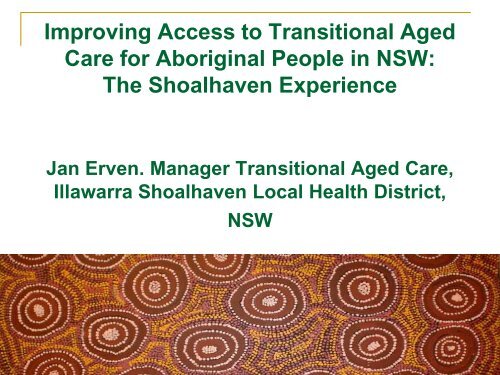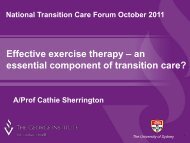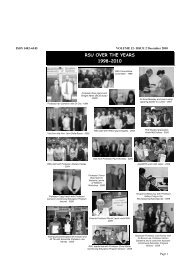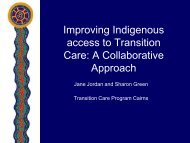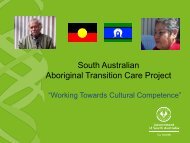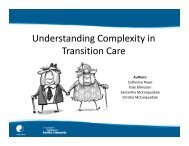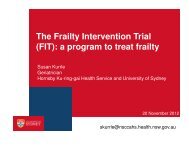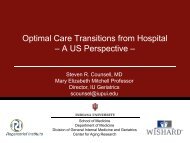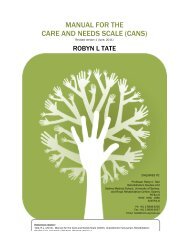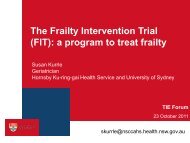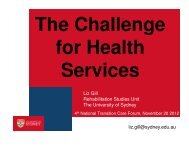Jan Erven
Jan Erven
Jan Erven
Create successful ePaper yourself
Turn your PDF publications into a flip-book with our unique Google optimized e-Paper software.
Improving Access to Transitional Aged<br />
Care for Aboriginal People in NSW:<br />
The Shoalhaven Experience<br />
<strong>Jan</strong> <strong>Erven</strong>. Manager Transitional Aged Care,<br />
Illawarra Shoalhaven Local Health District,<br />
NSW
Local Health Districts in NSW
Illawarra Shoalhaven Local Health District<br />
Hospitals
Shoalhaven Area<br />
• 4660km 2 (136km from end to end)<br />
• 49 towns and villages including Nowra<br />
• Population 97,000<br />
• 14% of population aged 70 and over<br />
(highest in ISLHD)<br />
• 3.3% of population identify as Aboriginal<br />
live in the Shoalhaven area (highest in<br />
ISLHD)
Demographics of the Aboriginal<br />
Population<br />
• 466 Aboriginal people aged over 50 years<br />
live in the Shoalhaven area.<br />
• There are a number of separate Aboriginal<br />
communities in the Shoalhaven area:<br />
o The Jerringa Community at Orient Point<br />
o The Dharwal community at Sanctuary Point<br />
o The Wreck Bay community at Jervis Bay in<br />
the ACT<br />
o Small communities in Bomaderry and Nowra
Housing issues for Aboriginal people<br />
living in the Shoalhaven<br />
• Aboriginal Communities (missions)<br />
• Holiday homes<br />
• Relocatable homes<br />
• Caravan parks<br />
• Rural properties (some with poor access)<br />
• Some high crime areas<br />
• Difficulties with modifying housing for<br />
elderly people
Transport Issues<br />
•Public transport virtually non-existent<br />
•Long distances and time to travel to<br />
access services, shopping and<br />
community facilities<br />
•Ambulance takes 20-30 minutes to<br />
get to some areas<br />
•Many villages have only poor single<br />
road access
Health issues for Aboriginal people<br />
•Have to “go to town” for many<br />
services including the Aboriginal<br />
Medical Service<br />
•Heavy reliance on neighbours for help<br />
•Outpatient services in few locations<br />
•Medical Specialist access very limited
Shoalhaven Transitional Aged Care<br />
Service (STACS)<br />
• The Shoalhaven Hospital at Nowra<br />
commenced Transitional Aged Care Services<br />
in October 2006 with 10 places and has<br />
grown to 30 community places in September<br />
2011.<br />
• From 2006-2010 the utilisation of the service<br />
by Aboriginal people was low, with only 4<br />
people completing the program.<br />
• A number of strategies were implemented but<br />
these did not increase the referral rate.
Factors influencing low referral rates for<br />
Aboriginal people<br />
• There were 570 emergency department<br />
attendances of Aboriginal people over 50 years<br />
in the Shoalhaven in 09/10 but only 32 inpatient<br />
separations for the same period<br />
• If Aboriginal people were admitted, they had a<br />
very short length of stay (less than 48 hours)<br />
and missed having an ACAT assessment, and<br />
therefore missed the opportunity for TACP<br />
• Aboriginal people living in some of the Missions<br />
did not have access to the program
Some of the perceived barriers for Aboriginal<br />
referrals to TACP<br />
• Loss or breakdown of families<br />
• Social difficulties including alcoholism, substance abuse,<br />
violence and family violence in the communities<br />
• Mistrust of mainstream health services by Aboriginal<br />
people<br />
• Lack of education and support for the chronically ill in<br />
some of the Aboriginal communities<br />
• Lack of role models<br />
• Lack of knowledge of the program by local GPs, both<br />
Aboriginal and non Aboriginal
Developing a new TACP model for Aboriginal<br />
People in the Shoalhaven<br />
• Consulted with the Area Manager for Aboriginal<br />
Services and the hospital Aboriginal Liaison Officers<br />
(ALO’s) to identify issues on low uptake of the<br />
program by Aboriginal people.<br />
• Reviewed hospital admission and separation data to<br />
gain evidence of lower than expected numbers of<br />
Aboriginal people admitted to hospital.<br />
• Reviewed the existing model to identify any<br />
improvements to be made on the access to the<br />
service<br />
• Proposed a new model to access the service for<br />
Aboriginal people in the 10/11 3 rd tranche funding
Proposed plan for the new model in the<br />
Shoalhaven<br />
• Employment of an Aboriginal Enrolled Nurse who would<br />
be accepted by the communities and provide case<br />
management of the clients and their carers<br />
• Admit Aboriginal people into the Hospital in the Home<br />
program as an inpatient admission, if appropriate and<br />
eligible, from the Emergency Department. As well as<br />
target all inpatient Aboriginal patients over 50 years as<br />
possible referrals to the program<br />
• Carry out joint ACAT assessments with the Aboriginal<br />
Enrolled Nurse and the ACAT worker in the hospital and<br />
in the community for the Hospital in the Home clients<br />
• Evaluate the effectiveness of the program after 12<br />
months
Implementation of the model<br />
• The extra 2 places allocated to the Shoalhaven<br />
service commenced on 1 November 2010<br />
specifically targeting Aboriginal people<br />
• Employment of an Aboriginal EEN, Shane Smith<br />
• Negotiation with brokered service, to provide<br />
personal care services and domestic assistance<br />
in the Aboriginal communities<br />
• National registration scheme allowed medical,<br />
nursing and allied health staff to provide<br />
services in the ACT (Wreck Bay).
The Current STACS Team<br />
• 1.0 FTE Nurse Manager<br />
• 1.9 FTE Physiotherapists<br />
• 1.9 FTE Occupational Therapists<br />
• 2.0 FTE Therapy Assistants<br />
• 1.6FTE Social Workers<br />
• 3.0 FTE Clinical Nurse Specialists<br />
• 1.0 FTE Registered Nurse<br />
• 1.0 Endorsed Enrolled Nurse<br />
• 0.5 FTE Dietician
Strategies that have been<br />
implemented by the Aboriginal EN<br />
• Visits to the local communities and health<br />
workers to explain the program<br />
• Liaison with the Aboriginal Liaison Officer (ALO)<br />
in the hospital to increase referrals<br />
• Education to increase awareness amongst allied<br />
health teams on the wards that the program is<br />
targeting Aboriginal people<br />
• Liaison with the Aboriginal Home Care services<br />
to promote the program being available to<br />
Aboriginal people
Aboriginal Service Providers assisting with<br />
access for Aboriginal clients to the program<br />
• Wreck Bay community clinic<br />
• Jerringa community clinic<br />
• Nowra Aboriginal Medical Centre<br />
• Weja Aboriginal Home Care Service<br />
• Illaroo Cooperative Aboriginal Corporation<br />
• Aunty Jean’s Chronically Ill Exercise<br />
Workshop<br />
• Bush Telegraph
Results for clients so far<br />
• 12 Aboriginal people have entered the program in the<br />
last 10 months<br />
• 4 people returned to hospital and 1 died<br />
• 1 person was non compliant<br />
• 3 people have completed the program and require<br />
minimal ongoing community services<br />
• 8 clients improved their Barthel scores while on the<br />
program<br />
• 1 person completed the program without any further<br />
community supports<br />
• 2 people are currently in the program<br />
• None of the Aboriginal people required residential care<br />
following the completion of the program
Results for the Service<br />
• The employment of the Aboriginal EEN within<br />
STACS has increased the capacity of the staff to<br />
meet the culturally needs of Aboriginal people.<br />
• The new model has improved the utilisation of<br />
the transitional aged care program by Aboriginal<br />
people by matching intake processes to cultural<br />
patterns of health care use.<br />
• Very positive feedback from the Aboriginal<br />
people and their families involved in the program
Results Continued<br />
• Providing access to the program for Aboriginal<br />
people, which was not previously available,<br />
living in the ACT in the Wreck Bay community.<br />
• The Aboriginal enrolled nurse has developed<br />
partnerships, trust and relationships with the<br />
local communities and services and has<br />
improved the acceptance by Aboriginal people<br />
of the program.<br />
• Improved ability for SESIH to meet the needs of<br />
this disadvantaged group in the Shoalhaven<br />
community and assists in the “Closing the Gap”<br />
strategy.
Future Developments<br />
• Formal review of the program to commence in<br />
November 2011. Participation in the review<br />
process from the Australian Health Services<br />
Research Institute, University of Wollongong<br />
• Using this model for Aboriginal clients in other<br />
services in NSW, living in urban areas<br />
• More importantly, the Aboriginal EEN gained a<br />
scholarship to present the model and the service<br />
to the National Rural Health Nurses Conference<br />
in Perth last week.
Ackowledgements<br />
• I would like to thank Shane Smith and Kay Gilbert from<br />
STACS who assisted in providing the information for this<br />
presentation


